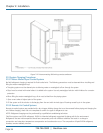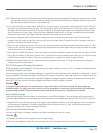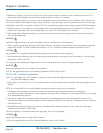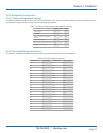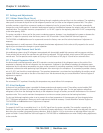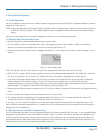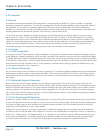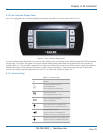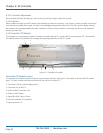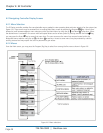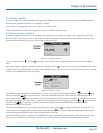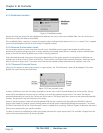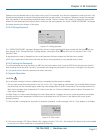
724-746-5500 | blackbox.com
Page 44
724-746-5500 | blackbox.com
Chapter 4: E2 Controller
4. E2 Controller
4.1 General
The advanced microprocessor-based E2 Series controller is a highly versatile and flexible A/C system controller. It is designed
primarily for precision air conditioners. The controller is equipped with flexible software capable of meeting the specific needs of
the application. The controller is completely programmed at the factory and most applications will require no field setup.
However, you can easily view and adjust the default setpoints and their ranges from the user interface display. The program and
operating parameters are permanently stored on Flash memory in case of power failure.
The E2 Series controller is designed to manage temperature and humidity levels to user-defined setpoints via control output
signals to the A/C system. Control parameters have variable outputs from 0 to 100% of the full rated capacity. The controller
continually receives inputs for the measurable control conditions (temperature and relative humidity) via sensors installed in the
cabinet. The internal logic determines if the conditions require cooling or dehumidification. Control setpoints are established to
maintain the room's designed conditions. The controller responds accordingly to changes and controls the output(s) to the
air-conditioning system so temperature/humidity conditions reach the user-defined control setpoints.
4.1.1 Features
4.1.1.1 Field Configurable
The program for the E2 Series controller is field configurable, ao the operator can select control parameters and setpoints specific
to the application. Operator interface for the E2 controller is provided via an attractive, door-mounted user interface display panel.
The display panel has a backlit LCD graphical display and function keys, giving the user complete control and monitoring capability
of the precision cooling system. The menu driven interface provides users with the ability to scroll through and enter various menu
loops. Monitoring of room conditions and A/C system operation is allowed without entering a password. Modifications to the
control setpoints require the use of a password.
4.1.1.2 Password Protection
You can access the Info menu and Alarms log without a password. The controller recognizes predetermined security levels before
allowing access to display screens containing critical variables. Three secured menu levels (Control, Service, and Factory) support
unique passwords that must be entered to access the menu screens so only authorized personnel may perform modifications to
the settings.
4.1.1.3 Restorable Setpoint Parameters
Upon initial startup, the A/C system operates using the setpoints programmed by the factory. The customer may enter new
operating parameters in the Control and Service menus and the system will then operate accordingly. The new setpoints may be
stored as Customer Default setpoints. The primary setpoints entered by the factory still remain stored in the controllers' memory
as Factory setpoints. The setpoints for the system may be re-adjusted in the Control menu at any time. If it becomes necessary,
the customer may restore the setpoints back to the Customer Default setpoint values or to the original Factory (primary) setpoint
values in the Service menu (See Section 4.5.5.9).
4.1.1.4 A/C Grouping pLAN Operation
Multiple A/C system controllers can be connected (grouped) to a Private LAN (pLAN) local network, allowing the communication
of data and information from each controller to a central control terminal or lead controller. Use the lead controller display screens
to monitor and adjust group control variables for the individual system controllers. Each E2 controller connected to the pLAN
network must be identified with its own unique address.
Multiple A/C units consisting of up to eight (8) precision air conditioners equipped with like controllers may be controlled and
monitored via the E2 series controller. With multiple A/C units each unit can selectively be configured as "Active" to operate as a
primary A/C, “Capacity Assist” for staged operation, or as “Standby” to come on-line in case of a failed air-conditioning unit to
ensure continuous availability. The controller may also be configured to rotate units with timed duty cycling to promote equal
run-time and ensure that each A/C unit within the rotating group is operationally exercised on a periodic timed basis.



